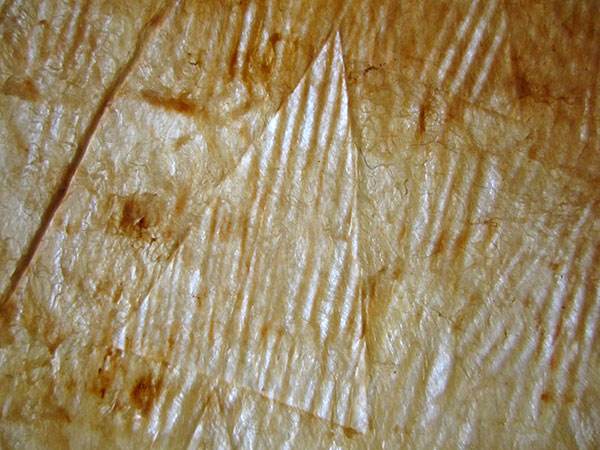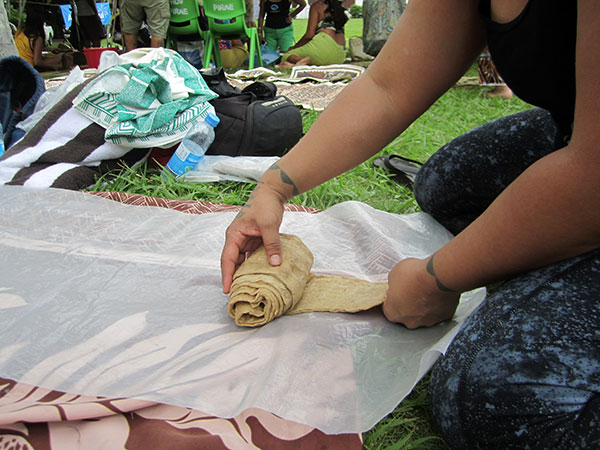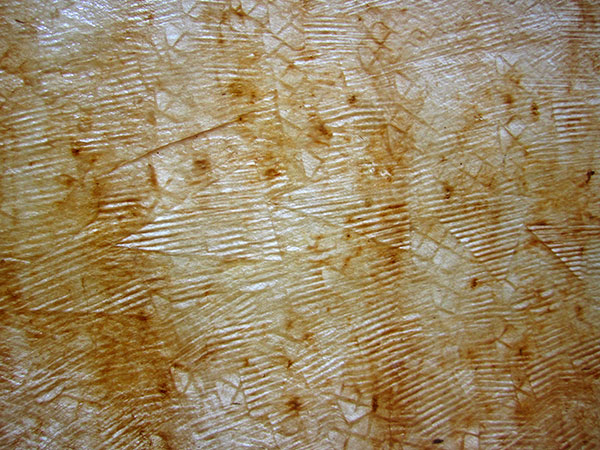Making Tapa Eastern Pacific Style
Te Rangi Hiroa (Peter H. Buck) writes in Arts and Crafts of the Cook Islands that the tapa makers of the time (1944) wrapped the pre-beaten bark in banana leaves and left it to ret for three days. Today’s tapa makers on Atiu usually beat the bark right away. When making a larger piece such as a garment, several strips are joined together with glue. In times past, retting, a water-aided fermentation process, loosened the fibres and enabled the tapa makers to join the pieces together by a kind of felting (beating). Following a correspondence with Hawaiian kapa maker Dennis Kana’e Keawe, at the Atiu Fibre Arts Studio, at the Atiu Fibre Arts Studio we conducted a number of experiments in 1988/89 to try this method. He joined us in beating the prepared bark. In 2013, I agreed with the art teacher at Enuamanu School to repeat the experiment.
Atiu does not have running streams and water shortage is often a problem. However there is one particular beach, Avatapu, the beach on which the Edna was stranded, that Atiu women use to ret lemon hibiscus bark for making dancing costumes. That’s where, in 1989, we soaked our shaved bundles of banyan roots instead of heating them to enable us to get the bark off the wooden core. This process both softens and loosens the bark and preserves it at the same time. In 20213, the art students came up with an ingenious way of insuring that the bundles would stay together, by plaiting a coconut frond around the bundle.
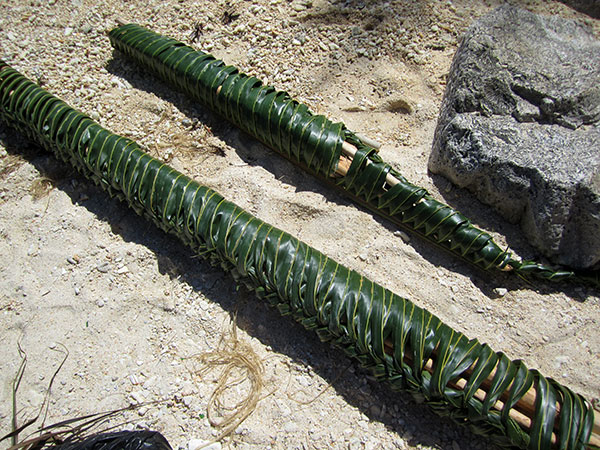 Heavy boulders of coral have been thrown up on the beach’s edge at Avatapu. These serve as weight to keep the bundles submerged in the water and in place when the sometimes rough sea tries to steal them away. The beach is right next to our harbour and the cargo boat that brings cargo from Rarotonga to the sister islands had arrived that day.
Heavy boulders of coral have been thrown up on the beach’s edge at Avatapu. These serve as weight to keep the bundles submerged in the water and in place when the sometimes rough sea tries to steal them away. The beach is right next to our harbour and the cargo boat that brings cargo from Rarotonga to the sister islands had arrived that day.
 I am not sure whether it was light or salt water – or the absence thereof – that caused the basket’s pattern to be imprinted on some of the outer roots’ bark. Worth conducting more experiments to find out how I can achieve that purposely, I guess, but not right now. The bark we have removed gets rolled up in leaves and is left to ferment.
I am not sure whether it was light or salt water – or the absence thereof – that caused the basket’s pattern to be imprinted on some of the outer roots’ bark. Worth conducting more experiments to find out how I can achieve that purposely, I guess, but not right now. The bark we have removed gets rolled up in leaves and is left to ferment.
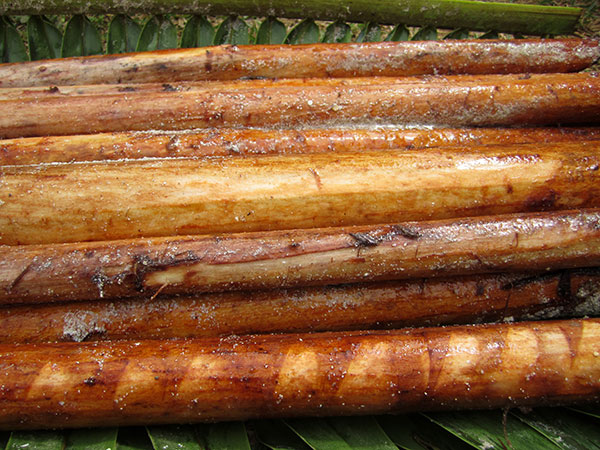 Fermenting their paper mulberry bark is a distinctive feature of Hawaiian kapa (their word for barkcloth). During the Tahiti Tapa Festival in 2014, Honolulu tapa expert Moana Eisele and her assistant, Kamalu du Preez, demonstrated to us their innovative method. Fermented wauke (Hawaiian for Broussonetia papyrifera or paper mulberry) becomes very delicate to work with. Especially when you plan to make a wider sheet, moving it forward on the kua (Hawaiian for wooden anvil) can be quite a challenge. Moana therefore beats her kapa on a large sheet of plastic.
Fermenting their paper mulberry bark is a distinctive feature of Hawaiian kapa (their word for barkcloth). During the Tahiti Tapa Festival in 2014, Honolulu tapa expert Moana Eisele and her assistant, Kamalu du Preez, demonstrated to us their innovative method. Fermented wauke (Hawaiian for Broussonetia papyrifera or paper mulberry) becomes very delicate to work with. Especially when you plan to make a wider sheet, moving it forward on the kua (Hawaiian for wooden anvil) can be quite a challenge. Moana therefore beats her kapa on a large sheet of plastic.
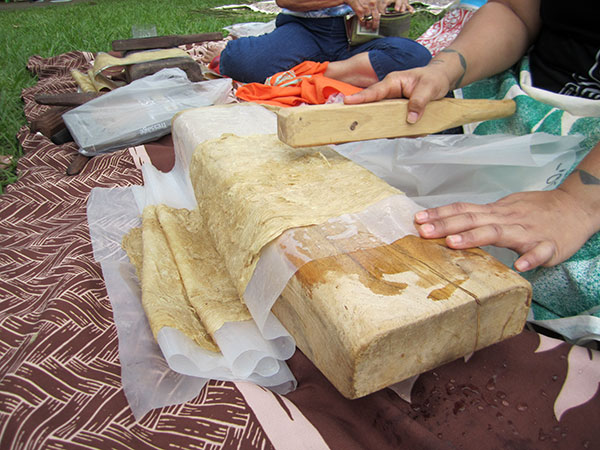 This serves to hold it when folding it over to felt together the fibres…
This serves to hold it when folding it over to felt together the fibres…
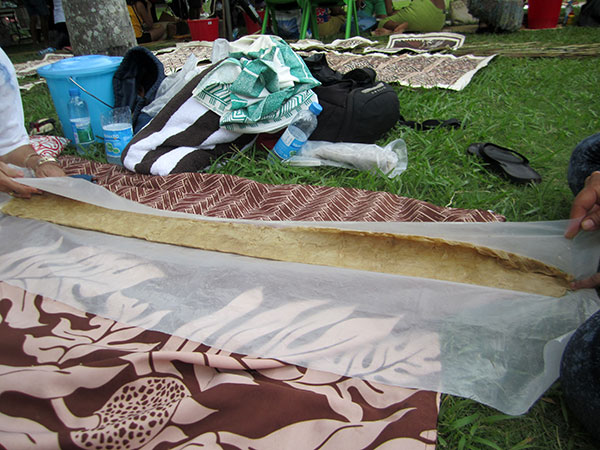 …and if she wants to keep an unfinished piece for another beating session the next day, it is ideal for storage, prevents the bast from drying out and might even keep it fermenting.
…and if she wants to keep an unfinished piece for another beating session the next day, it is ideal for storage, prevents the bast from drying out and might even keep it fermenting.
 Hawaiians have patterned i‘e kuku (tapa beaters) with which they can ‘imprint’ a watermark into the moist bark that has been finished beeting into a fine sheet. Our Hawaiian friend Kana’e gave us a beautiful i’e which he had carved himself when he visited the Atiu Fibre Arts Studio in 1989. I love working with it, because it is well-balanced and wonderful to handle.
Hawaiians have patterned i‘e kuku (tapa beaters) with which they can ‘imprint’ a watermark into the moist bark that has been finished beeting into a fine sheet. Our Hawaiian friend Kana’e gave us a beautiful i’e which he had carved himself when he visited the Atiu Fibre Arts Studio in 1989. I love working with it, because it is well-balanced and wonderful to handle.
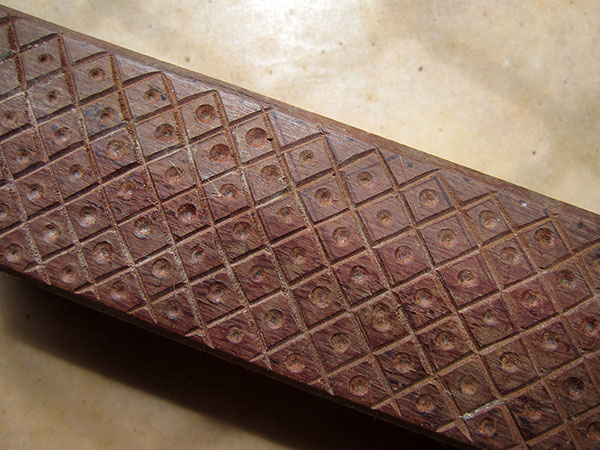 I used it to experiment with a small piece of mati (ficus tinctoria, dye fig). I had also put some triangular pieces of cardboard between the tutunga (wooden anvil) and the bark to try out some different ways of watermarking. As we can see here, it worked.
I used it to experiment with a small piece of mati (ficus tinctoria, dye fig). I had also put some triangular pieces of cardboard between the tutunga (wooden anvil) and the bark to try out some different ways of watermarking. As we can see here, it worked.

